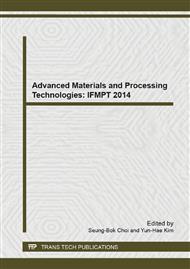[1]
Qi Luo, Shaowen Huang, etc. Analysis of deformation properties and stress of rubber particle modified cement concrete. Journal of Nanchang University (Natural Science), 2008, 32(6): 564-567.
Google Scholar
[2]
Dengxiang Zhang, Weijun Yang. Fly ash and water paste hydration kinetics model. Journal of Changsha University of Science and Technology (Natural Science Edition), 2008. 5(3): 88-92.
Google Scholar
[3]
Xuezhuang Zhao. Principle of chemical reaction kinetics. Beijing: Higher Education Press, 1984. 1–2.
Google Scholar
[4]
FERNANDEZ-JIMENEZ A, PUERTAS F. Alkali-activated slag cements: kinetic studies. Cement and Concrete Res, 1997, 27(3): 359−368.
DOI: 10.1016/s0008-8846(97)00040-9
Google Scholar
[5]
FERNANDEZ-JIMENEZ A, PUERTAS F, ARTEAGA A. Determination of kinetic equations of alkaline activation of blast furnace slag by means of calorimetric data. J Therm Anal Calori, 1998, 52(2): 945−955.
Google Scholar
[6]
de SCHUTTER G. Hydration and temperature development of concrete made with blast-furnace slag cement. Cement and Concrete Res, 1999, 29(1): 143−149.
DOI: 10.1016/s0008-8846(98)00229-4
Google Scholar
[7]
KRSTULOVIC R, DABIC P. A conceptual model of the cement hydration process. Cement and Concrete Res, 2000, 30(5): 693−698.
DOI: 10.1016/s0008-8846(00)00231-3
Google Scholar
[8]
Xuequan Wu. Study on the kinetics of hydration of slag cement. Journal of the Chinese Ceramic Society, 1988, 16(5): 423-429.
Google Scholar
[9]
Qijun Yu, Shanba Wang, etc. Research of road cement properties and its hydration kinetics, Report of ShandongInstitute of Building Materials, 1994, 8(2).
Google Scholar
[10]
Youzhi Chen, Xincheng Pu. Research of neutral sodium alkali slag cement hydration kinetics. Journal of Chongqing Architecture University, 1999, 21(4): 29-33.
Google Scholar
[11]
Lang Wu, Guquan Song, Lin Liu. The microstructure model of the cement hydration process and the numerical calculation. Sichuan Building science and Research, 2010, 36(6): 185-187.
Google Scholar
[12]
Jianjun Zheng, Xianwei Pang. Prediction method of hydration degree based on computer simulation. Journal of Building Materials, 2008, 11(4): 403-408.
Google Scholar
[13]
Jingfu Zhang. The hydration, hardening and properties of class G oilwell cement. Ph D thesis of Zhejiang University, (2001).
Google Scholar


